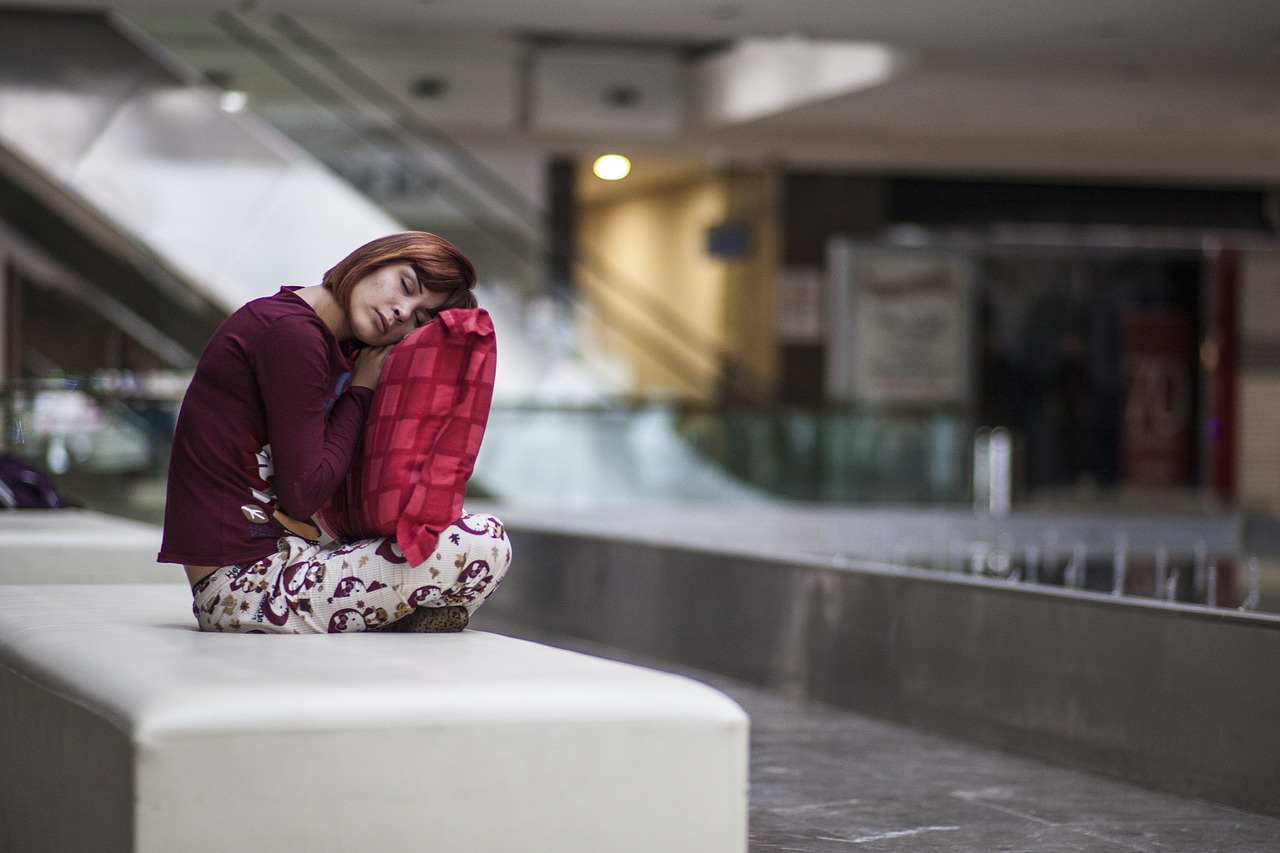Sleepwalking - A State of Conscious or Unconscious?
Sleepwalking, or somnambulism, has fascinated scientists, doctors, and curious minds alike for centuries. But what is it really? Is it a conscious act, or is the individual completely unaware of their actions? This phenomenon typically occurs during the deeper stages of non-REM sleep, where the body is in a state of rest, yet the mind seems to wander. Imagine this: your friend gets up in the middle of the night, walks to the kitchen, and starts making a sandwich—all while still asleep! It raises intriguing questions about the boundaries of consciousness and the complexities of our sleep cycles.
To understand sleepwalking, we must first explore its **definition** and **prevalence**. Research indicates that sleepwalking affects approximately 1-15% of the population, with children being more prone to this disorder than adults. This discrepancy begs the question: why do some people sleepwalk while others do not? Is it merely a quirk of the brain, or does it stem from deeper psychological or physiological issues? As we dive deeper into this topic, we will uncover the various factors that contribute to sleepwalking episodes, the common symptoms associated with it, and the treatment options available. By the end of this exploration, we hope to shed light on whether sleepwalking is a conscious or unconscious state and what that means for those who experience it.
Interestingly, sleepwalking may not solely be a result of individual circumstances; it can also be influenced by genetic factors. Studies show that sleepwalking often runs in families, suggesting a hereditary component. But how does this genetic predisposition manifest? Could it be that certain families possess unique sleep patterns that make them more susceptible to somnambulism? As we delve into the **causes of sleepwalking**, we will also look at environmental triggers, lifestyle choices, and stress factors that can provoke episodes. By piecing together these elements, we aim to paint a clearer picture of this captivating phenomenon.
In conclusion, sleepwalking is a complex interplay of genetic, environmental, and psychological factors, raising profound questions about the nature of consciousness itself. Are sleepwalkers truly unconscious, or do they exist in a state of partial awareness? As we unravel the layers of this intriguing disorder, we invite you to ponder your own experiences with sleep and consciousness. Could you be one of the many who have walked the fine line between sleep and wakefulness?
- What are the common causes of sleepwalking? Sleepwalking can be triggered by various factors, including genetics, sleep deprivation, stress, and certain medications.
- Is sleepwalking dangerous? Yes, it can be dangerous if the sleepwalker engages in risky behaviors or injures themselves while moving around.
- Can sleepwalking be treated? Yes, treatment options include lifestyle changes, cognitive-behavioral therapy, and in some cases, medication.
- Are children more likely to sleepwalk than adults? Yes, children are more prone to sleepwalking, but many outgrow it as they age.

Understanding Sleepwalking
Sleepwalking, also known as somnambulism, is a fascinating disorder that captures our imagination, often evoking images of someone wandering through their home in a trance-like state. But what exactly is sleepwalking? At its core, it is a behavior disorder that occurs during deep sleep, where an individual walks or performs other complex actions while remaining largely unaware of their surroundings. Imagine a person, eyes wide open yet completely oblivious, moving about as if they were awake, but in reality, they are still deeply asleep. This phenomenon can occur at any age, but it is most commonly observed in children, with estimates suggesting that about 1-15% of children experience sleepwalking at some point in their lives.
The prevalence of sleepwalking varies widely among different age groups. In children, it typically peaks between the ages of 4 and 8, with many outgrowing the condition as they reach adolescence. In adults, however, sleepwalking is less common but can be triggered by various factors, including stress, sleep deprivation, or even certain medications. It's almost like a hidden world, where the sleepwalker is both present and absent, navigating through their environment without any conscious awareness. This duality raises intriguing questions about the nature of consciousness itself.
To better understand sleepwalking, it’s essential to recognize that it is not merely a quirky behavior but a complex interplay of neurological and environmental factors. During a sleepwalking episode, a person may perform a wide range of actions, from simple walking to more elaborate behaviors like cooking or even leaving the house. This complexity adds to the mystique of sleepwalking, as it blurs the lines between being awake and asleep. The experience can be disorienting for both the sleepwalker and those around them, especially if the individual engages in potentially dangerous activities.
In summary, sleepwalking is a unique sleep disorder that raises many questions about our understanding of consciousness and behavior. As we delve deeper into the causes, symptoms, and treatments, we will uncover the layers of this intriguing phenomenon. Understanding sleepwalking is not just about recognizing the behavior; it also involves exploring the underlying mechanisms and potential implications for those affected.

Causes of Sleepwalking
Sleepwalking is a fascinating phenomenon that often leaves both the sleepwalker and their loved ones puzzled. The reasons behind why someone might engage in sleepwalking are as varied as the individuals themselves. Understanding these causes is essential for anyone looking to manage or mitigate the condition. Several factors contribute to sleepwalking, including genetic predispositions, environmental triggers, sleep deprivation, and even stress. Each of these elements can play a significant role in determining who is more likely to experience sleepwalking episodes.
Research suggests that sleepwalking can indeed run in families. If you have a family member who sleepwalks, there’s a chance you might too. This genetic link raises questions about whether sleepwalking is inherited or if environmental factors play a significant role in its development. Studies show that first-degree relatives of sleepwalkers are more likely to experience similar episodes, indicating a hereditary component. For instance, if both parents have a history of sleepwalking, their children are at a higher risk of developing the disorder.
Family studies have provided compelling evidence supporting the idea that genetics play a role in sleepwalking. In a fascinating study, researchers found that about 60% of individuals who sleepwalk have a relative who also experiences the condition. This strong correlation suggests that there may be specific genes that predispose individuals to sleepwalking. Understanding these genetic markers could pave the way for better treatment options in the future.
Identifying risk factors is crucial for understanding who is more susceptible to sleepwalking. Factors such as age, sleep disorders, and certain medications can increase the likelihood of sleepwalking episodes. For example, children are more prone to sleepwalking than adults, with many outgrowing the condition as they mature. Additionally, individuals with sleep disorders like sleep apnea or restless leg syndrome may also be at a heightened risk. Certain medications, particularly those affecting the central nervous system, can also trigger sleepwalking episodes.
Beyond genetics, environmental influences can significantly impact the occurrence of sleepwalking. The sleep environment, including factors like noise, temperature, and even the comfort of your mattress, can contribute to sleep disturbances that lead to sleepwalking. Lifestyle choices such as alcohol consumption, irregular sleep schedules, and high-stress levels can also act as triggers. Imagine trying to sleep in a noisy, chaotic environment; the likelihood of a restless night—and potentially sleepwalking—dramatically increases. Thus, creating a peaceful sleep environment is essential for those prone to sleepwalking.
In summary, the causes of sleepwalking are multifaceted and can stem from a combination of genetic and environmental factors. By understanding these triggers, individuals can take proactive steps to minimize their risk and improve their overall sleep quality.
- Can sleepwalking be inherited? Yes, sleepwalking often runs in families, indicating a genetic predisposition.
- What age group is most affected by sleepwalking? Children are more likely to sleepwalk, with many outgrowing the condition.
- Are there any specific environmental factors that trigger sleepwalking? Yes, factors such as noise, temperature, and stress levels can contribute to sleepwalking episodes.
- How can sleepwalking be treated? Treatment options include lifestyle modifications, therapy, and in some cases, medication.

Genetic Factors
When we dive into the world of sleepwalking, one of the most intriguing aspects to consider is the role of genetics. Research has shown that sleepwalking, or somnambulism, can indeed run in families, suggesting that our genes might hold some of the answers to this puzzling phenomenon. Imagine a family where one member sleepwalks; it’s not uncommon to find that other family members have had similar experiences. This familial connection raises the question: are we simply victims of our genetic makeup?
Studies indicate that the likelihood of sleepwalking increases significantly among first-degree relatives. For instance, if a parent was a sleepwalker, the chances of their child experiencing the same disorder can be as high as 10-15%. This statistic is not just a number; it highlights a pattern that researchers are keen to understand. The genetic predisposition may be linked to specific genes that influence sleep patterns or behaviors, although the exact mechanisms are still being explored.
To put it into perspective, let's consider a hypothetical family tree:
| Relation | Sleepwalking Incidence |
|---|---|
| Parent | Sleepwalker |
| Sibling | Sleepwalker |
| Child | Potential Sleepwalker |
This table illustrates how sleepwalking can be passed down through generations, making it crucial for families to be aware of their sleep history. But genetics is just one piece of the puzzle. Other factors, such as sleep disorders, medications, and environmental triggers, can also play significant roles in the development of sleepwalking. So, while your genes might nudge you toward sleepwalking, it's essential to consider the broader context.
Furthermore, identifying risk factors can be instrumental in understanding who is more susceptible to sleepwalking. These factors can include:
- Age: Sleepwalking is more common in children, particularly between the ages of 4 and 8.
- Sleep Disorders: Conditions like sleep apnea or restless leg syndrome can increase the likelihood of sleepwalking.
- Medications: Certain medications, especially those affecting the central nervous system, can trigger sleepwalking episodes.
In summary, while genetics plays a significant role in sleepwalking, it is not the sole determinant. Understanding the interplay between genetic predisposition and environmental factors can provide a more comprehensive view of why some individuals experience sleepwalking while others do not. So, the next time you hear of someone wandering the halls at night, remember that there might be a genetic story behind their midnight adventures!

Family Studies
Family studies have shed light on the intriguing genetic aspects of sleepwalking, revealing that this phenomenon is not merely a random occurrence but may be influenced by hereditary factors. Research indicates that sleepwalking tends to run in families, suggesting that if one family member experiences this condition, others may be at a higher risk. This familial tendency raises a fascinating question: could our genes be the silent puppeteers behind our midnight wanderings?
In numerous studies, the prevalence of sleepwalking among first-degree relatives—such as parents, siblings, and children—has been notably higher than in the general population. This familial clustering points to a potential genetic predisposition that researchers are keen to explore. For instance, a study conducted on twins found that if one twin was a sleepwalker, the other was significantly more likely to be one as well, supporting the idea that genetics plays a crucial role.
To illustrate the impact of genetics on sleepwalking, consider the following statistics gathered from various family studies:
| Relation | Incidence of Sleepwalking (%) |
|---|---|
| Identical Twins | 60-80% |
| Fraternal Twins | 30-50% |
| Parents | 45% |
| Siblings | 25% |
These figures highlight a compelling relationship between genetics and sleepwalking, suggesting that those with a family history of the disorder should be vigilant. It’s not just about the genes, though; the environment also plays a significant role. For example, children raised in households where sleepwalking is prevalent may develop similar behaviors, indicating that both genetic and environmental factors intertwine to create a complex web of influences.
Understanding the hereditary nature of sleepwalking is vital for developing effective treatment plans. If we can identify individuals at risk due to their family history, we may be able to implement preventive measures or interventions before sleepwalking becomes a significant issue. This knowledge empowers families to take proactive steps, such as creating a safer sleep environment and managing stress levels, which can further mitigate the risk of sleepwalking episodes.
In summary, family studies provide a crucial perspective on the genetic components of sleepwalking. They not only highlight the importance of familial connections in understanding this disorder but also open the door to further research aimed at unraveling the intricate relationship between our genes and our nighttime behaviors.
- What is sleepwalking? Sleepwalking, or somnambulism, is a disorder where individuals walk or perform other complex behaviors while still asleep.
- Is sleepwalking hereditary? Yes, studies suggest that sleepwalking can run in families, indicating a genetic predisposition.
- What triggers sleepwalking episodes? Factors such as sleep deprivation, stress, and certain environmental conditions can trigger sleepwalking.
- How can sleepwalking be treated? Treatment options include lifestyle modifications, therapy, and in some cases, medication.

Identifying Risk Factors
Understanding the risk factors associated with sleepwalking is crucial for both prevention and effective management. Sleepwalking, while often seen as a whimsical or harmless phenomenon, can lead to dangerous situations if left unchecked. Several elements can increase the likelihood of experiencing sleepwalking episodes, and recognizing these can help individuals and families take proactive steps to mitigate risks.
One of the primary risk factors is age. Sleepwalking is most common in children, particularly those aged 4 to 8 years. It’s fascinating to note that many children outgrow sleepwalking as they reach adolescence. However, for some, it can persist into adulthood. This age-related trend highlights the importance of monitoring sleepwalking behaviors in younger children, especially during periods of stress or sleep deprivation.
Another significant factor is the presence of sleep disorders. Conditions such as sleep apnea, restless leg syndrome, and night terrors can predispose individuals to sleepwalking. These disorders often disrupt normal sleep patterns, making it easier for someone to enter a state of somnambulism. Additionally, medications that affect the central nervous system can also trigger episodes. For example, sedatives and certain antidepressants may inadvertently lead to sleepwalking in some individuals.
Stress is another critical factor that cannot be overlooked. High levels of stress or anxiety can disrupt sleep, leading to fragmented sleep cycles that may trigger sleepwalking. Life changes, such as moving to a new home, starting a new job, or experiencing family issues, can contribute to increased stress levels. Moreover, lifestyle choices, such as irregular sleep schedules, excessive caffeine consumption, or alcohol use, can exacerbate the situation.
In summary, the risk factors for sleepwalking can be grouped into several categories:
- Age: Most common in children, often outgrown by adolescence.
- Sleep Disorders: Conditions like sleep apnea and restless leg syndrome.
- Medications: Certain drugs can trigger episodes.
- Stress and Anxiety: High stress levels can disrupt sleep.
- Lifestyle Choices: Irregular sleep patterns and substance use.
By identifying these risk factors, individuals can take steps to create a safer sleep environment and seek appropriate interventions. For instance, establishing a calming bedtime routine, ensuring a comfortable sleep environment, and addressing any underlying sleep disorders with a healthcare provider can significantly reduce the likelihood of sleepwalking episodes.

Environmental Triggers
When it comes to sleepwalking, the environment plays a surprisingly significant role in triggering episodes. Imagine your bedroom as a stage where various factors come together to either promote peaceful slumber or stir up a night of wandering. One of the most notable environmental triggers is sleep disturbances. These can be caused by loud noises, uncomfortable bedding, or even an unregulated room temperature. Just like how a slight draft can disrupt a cozy evening, these disturbances can lead to fragmented sleep, making it easier for someone to slip into a sleepwalking episode.
Another critical factor is the sleep environment itself. The layout of a room can either encourage or discourage sleepwalking behavior. For instance, a cluttered room filled with obstacles can increase the risk of injury if a sleepwalker stumbles around. Similarly, bright lights or screens emitting blue light right before bed can disrupt the body's natural circadian rhythms, leading to poor sleep quality. It's almost as if the room is a maze, and navigating it while asleep can result in unexpected detours.
Furthermore, lifestyle choices significantly impact sleepwalking episodes. Stress is a major player here; when life gets overwhelming, our sleep often suffers. High-stress levels can lead to increased occurrences of sleepwalking, as the body struggles to cope with the mental load. Additionally, consumption of alcohol or certain medications can alter sleep patterns, making sleepwalkers more prone to episodes. Just like a roller coaster, the ups and downs of stress and substance use can send someone into a wild ride of nocturnal activities.
To illustrate how various environmental factors interact, consider the following table that summarizes key triggers and their potential effects on sleepwalking:
| Environmental Trigger | Potential Effect |
|---|---|
| Loud Noises | Disrupts sleep and increases chances of sleepwalking |
| Cluttered Room | Increases risk of injury during sleepwalking |
| Blue Light Exposure | Disrupts circadian rhythm, leading to poor sleep quality |
| High Stress Levels | Increases likelihood of sleepwalking episodes |
| Alcohol Consumption | Alters sleep patterns, heightening risk of sleepwalking |
In conclusion, understanding these environmental triggers can be pivotal in managing sleepwalking. By creating a tranquil sleeping environment, reducing stress, and being mindful of lifestyle choices, individuals can significantly decrease the likelihood of sleepwalking episodes. It’s all about setting the stage for a restful night’s sleep, free from unexpected wanderings.
- What is sleepwalking? Sleepwalking, or somnambulism, is a disorder where individuals perform complex behaviors while still asleep.
- Can sleepwalking be inherited? Yes, research suggests that sleepwalking can run in families, indicating a genetic component.
- What are some common symptoms of sleepwalking? Symptoms can range from simple walking to performing complex tasks, often with little to no memory of the event.
- How can I prevent sleepwalking? Improving sleep hygiene, managing stress, and creating a safe sleep environment can help reduce episodes.

Symptoms and Diagnosis
Recognizing the symptoms of sleepwalking is crucial for accurate diagnosis. Sleepwalking episodes can vary widely in their presentation, which makes it essential for family members and caregivers to be vigilant. Individuals who sleepwalk often appear to be in a trance-like state, with their eyes open but not fully aware of their surroundings. They may engage in a variety of behaviors ranging from simple actions, like walking around the house, to more complex tasks such as cooking or even leaving the house. This unpredictability can be alarming, especially when the sleepwalker is unaware of their actions.
Common symptoms of sleepwalking include:
- Walking around while asleep
- Performing activities like eating, dressing, or even driving
- Talking or mumbling incoherently
- Exhibiting a blank stare or lack of responsiveness
- Difficulty waking the person during an episode
These behaviors can last anywhere from a few seconds to 30 minutes, and upon awakening, the individual typically has no memory of the event. This amnesia can make it challenging for loved ones to identify sleepwalking episodes unless they witness them directly. Additionally, sleepwalking can be accompanied by other sleep disorders, such as sleep apnea or night terrors, complicating the clinical picture.
To diagnose sleepwalking, healthcare professionals often rely on a combination of patient history and sleep studies. During an initial consultation, a doctor will typically ask questions about the individual's sleep patterns, family history of sleep disorders, and any potential triggers such as stress or medication use. They may also inquire about the frequency and duration of sleepwalking episodes to assess the severity of the condition.
In some cases, a sleep study (polysomnography) may be recommended. This involves monitoring the individual's sleep patterns in a controlled environment, allowing doctors to observe brain activity, heart rate, and breathing during sleep. Such studies can help distinguish sleepwalking from other sleep-related issues, ensuring that the correct diagnosis is made.
Overall, understanding the symptoms and diagnostic processes surrounding sleepwalking is vital for effective management and treatment. If you or someone you know exhibits signs of sleepwalking, seeking professional advice is essential to ensure safety and identify potential underlying causes.
What should I do if I see someone sleepwalking?
If you encounter someone who is sleepwalking, it’s best to guide them gently back to bed without waking them. Avoid startling them, as this can lead to confusion or distress.
Can sleepwalking be dangerous?
Yes, sleepwalking can pose risks, especially if the individual engages in potentially hazardous activities like cooking or going outside. Ensuring a safe sleep environment is crucial.
Is sleepwalking hereditary?
Research indicates that sleepwalking can run in families, suggesting a genetic predisposition. If a family member has experienced sleepwalking, others may be at a higher risk.
Can sleepwalking be treated?
Yes, treatment options exist and may include lifestyle changes, therapy, or medication depending on the severity and underlying causes. Consulting a healthcare professional is advisable for tailored solutions.

Common Symptoms
Sleepwalking can manifest in various ways, making it a fascinating yet perplexing phenomenon. Individuals who experience sleepwalking, or somnambulism, often engage in a range of behaviors while they are technically still asleep. These behaviors can vary from simple actions, like sitting up in bed, to more complex activities, such as walking around the house or even attempting to leave the premises. It’s important to note that during these episodes, the sleepwalker is generally unaware of their actions and will not remember them upon waking.
Some common symptoms of sleepwalking include:
- Walking or Running: This is the most recognized symptom, where the sleepwalker may walk around their home or, in some cases, venture outside.
- Performing Routine Activities: Sleepwalkers might engage in everyday tasks like dressing, eating, or even driving a car, all while in a sleep state.
- Blank Stare: Those experiencing sleepwalking often have a vacant expression on their face, indicating a lack of awareness of their surroundings.
- Difficulty Awakening: If someone tries to wake a sleepwalker, it often proves challenging, and they may respond in confusion or irritation.
- Unusual Behavior: This can include actions that are out of character for the individual, such as talking incoherently or exhibiting signs of agitation.
It's essential for family members or roommates to recognize these symptoms, as they can help in identifying and managing sleepwalking episodes. Observing a loved one during an episode can be both alarming and enlightening, as it provides insight into the complexities of sleep behavior. While sleepwalking can seem harmless, it can pose risks, especially if the sleepwalker encounters obstacles or attempts dangerous activities. Therefore, understanding these symptoms is crucial for ensuring safety and seeking appropriate treatment.
In many cases, sleepwalkers may not only display physical symptoms but also emotional ones. For instance, they might experience feelings of confusion or distress upon waking, especially if they are startled during an episode. This emotional component can sometimes lead to anxiety about going to sleep, creating a cycle that exacerbates the problem. Hence, recognizing the full spectrum of symptoms is vital for both the sleepwalker and their caregivers.
In conclusion, the symptoms of sleepwalking are diverse and can vary significantly from person to person. Understanding these symptoms can aid in early detection and intervention, ultimately leading to better management of this intriguing sleep disorder. If you suspect that someone you know is sleepwalking, it is advisable to consult a healthcare professional for further evaluation and guidance.

Diagnostic Procedures
Diagnosing sleepwalking can be quite a complex process, as it often requires a detailed understanding of the patient's sleep patterns and behaviors. Healthcare professionals typically start with a comprehensive patient history, which includes discussions about the frequency and nature of sleepwalking episodes, any known triggers, and the overall sleep environment. This initial assessment is crucial because it helps to rule out other potential sleep disorders that may present similar symptoms, such as night terrors or REM sleep behavior disorder.
In many cases, doctors may recommend a polysomnography, which is a type of sleep study conducted in a sleep clinic. During this overnight test, various physiological parameters are monitored, including brain waves, oxygen levels, heart rate, and breathing patterns. This detailed observation allows specialists to capture the sleepwalking episodes in real-time, providing invaluable insights into the patient's sleep architecture and any irregularities that may be contributing to the condition.
Another important aspect of the diagnostic process is the use of sleep diaries. Patients are often asked to keep a record of their sleep habits, including the time they go to bed, the quality of their sleep, and any episodes of sleepwalking or other unusual behaviors. This diary can help identify patterns or triggers that might not be immediately apparent during a clinical assessment.
Additionally, healthcare providers may utilize questionnaires to gather more information about the patient's sleep habits and lifestyle. These questionnaires often cover topics such as:
- Sleep duration and quality
- Stress levels
- Use of medications or substances
- Family history of sleep disorders
Ultimately, the goal of these diagnostic procedures is to create a comprehensive picture of the individual's sleep health. By combining patient history, polysomnography, sleep diaries, and questionnaires, healthcare professionals can develop a tailored approach to treatment, which may include lifestyle modifications, therapy, or medication, depending on the severity and underlying causes of the sleepwalking episodes.
Q: Can sleepwalking be dangerous?
A: Yes, sleepwalking can pose risks, especially if the individual attempts to leave the house or engages in activities that could lead to injury. It's essential to create a safe sleep environment to minimize these risks.
Q: Is sleepwalking hereditary?
A: Research indicates that sleepwalking can run in families, suggesting a genetic component. If a parent has a history of sleepwalking, their children may be at an increased risk.
Q: What should I do if I see someone sleepwalking?
A: It's best to gently guide the person back to bed without waking them, as waking a sleepwalker can lead to confusion and distress. Ensure their safety by removing any obstacles in their path.
Q: Can sleepwalking be treated?
A: Yes, treatment options are available and can include lifestyle changes, therapy, and in some cases, medication. Consulting a healthcare professional is the best way to determine an appropriate treatment plan.

Treatment Options
Treatment for sleepwalking varies significantly based on the severity of the condition and the underlying causes. If you or someone you know is experiencing sleepwalking episodes, it’s essential to consult with a healthcare professional to determine the best course of action. Treatment options can be broadly categorized into lifestyle modifications, therapies, and medications, each aimed at reducing the frequency and intensity of sleepwalking episodes.
One of the most effective approaches is making lifestyle modifications. This can include improving sleep hygiene by establishing a consistent sleep schedule, creating a relaxing bedtime routine, and ensuring a comfortable sleep environment. For instance, reducing noise and light in the bedroom and maintaining a cool temperature can contribute significantly to better sleep quality. Moreover, managing stress through techniques such as meditation or yoga can also help. Stress is a known trigger for sleepwalking, so incorporating relaxation techniques into daily routines can be beneficial.
In addition to lifestyle changes, therapy can play a crucial role in treatment. Cognitive-behavioral therapy (CBT) has shown promise in addressing the psychological aspects of sleepwalking. Through CBT, individuals can learn to identify and manage triggers, develop coping strategies, and ultimately reduce the likelihood of episodes. In some cases, therapy may also involve family members to create a supportive environment that fosters better sleep health.
For more severe cases of sleepwalking, particularly when episodes pose a risk of injury, medications may be prescribed. Medications such as benzodiazepines or certain antidepressants can help regulate sleep patterns and reduce the frequency of sleepwalking episodes. However, medication should always be considered a last resort and used under the guidance of a healthcare provider, as it may come with side effects and is not a one-size-fits-all solution.
It's also important to identify and address any underlying conditions that may contribute to sleepwalking. For example, sleep disorders such as sleep apnea or restless leg syndrome can exacerbate sleepwalking episodes. By treating these conditions, individuals may experience a reduction in sleepwalking incidents. Below is a table summarizing the various treatment options available:
| Treatment Type | Description |
|---|---|
| Lifestyle Modifications | Improving sleep hygiene, managing stress, and establishing a regular sleep schedule. |
| Therapies | Cognitive-behavioral therapy to address triggers and develop coping strategies. |
| Medications | Benzodiazepines and certain antidepressants to regulate sleep patterns. |
| Underlying Conditions | Treating sleep disorders such as sleep apnea and restless leg syndrome. |
In conclusion, while sleepwalking can be a perplexing and sometimes alarming condition, various treatment options are available to help manage and reduce its occurrence. By combining lifestyle changes, therapeutic interventions, and, when necessary, medications, individuals can regain control over their sleep and reduce the risks associated with sleepwalking.
- What is sleepwalking? Sleepwalking, or somnambulism, is a disorder where individuals walk or perform complex behaviors while in a state of sleep.
- Are there any risks associated with sleepwalking? Yes, sleepwalking can lead to injuries if the individual encounters obstacles or hazards while walking.
- Can sleepwalking be treated? Yes, treatment options include lifestyle changes, therapy, and medications based on the severity of the condition.
- Is sleepwalking hereditary? Research suggests that sleepwalking can run in families, indicating a potential genetic component.
- How can I help someone who sleepwalks? Ensure their sleep environment is safe, avoid waking them abruptly, and consult a healthcare professional for guidance.

Lifestyle Modifications
Lifestyle modifications can play a pivotal role in managing sleepwalking episodes and enhancing overall sleep quality. By adopting certain habits and making adjustments to your environment, you can significantly reduce the frequency of these nocturnal adventures. Think of it as fine-tuning the orchestra of your sleep—each element must harmonize to create a peaceful symphony. So, what are some effective changes you can implement?
First and foremost, establishing a consistent sleep schedule is crucial. Going to bed and waking up at the same time every day helps regulate your body's internal clock. This consistency can lead to deeper, more restorative sleep, which might help diminish the occurrences of sleepwalking. Imagine your body as a finely tuned watch; if the gears are out of sync, it won't tell the right time.
Moreover, creating a calming bedtime routine can signal to your brain that it's time to wind down. Activities such as reading a book, taking a warm bath, or practicing relaxation techniques can help ease the transition into sleep. Avoiding stimulating activities or screens at least an hour before bedtime is also essential. The blue light emitted by devices can interfere with melatonin production, making it harder to fall asleep. Instead of scrolling through your phone, consider journaling your thoughts or practicing mindfulness meditation.
Another important factor is the sleep environment itself. Your bedroom should be a sanctuary for sleep—dark, quiet, and cool. Consider using blackout curtains to block out light, earplugs or white noise machines to mask disruptive sounds, and maintaining a comfortable temperature. A clutter-free space can also promote relaxation, so take some time to tidy up before bed. You might be surprised at how much a peaceful environment can impact your sleep quality.
Additionally, paying attention to your diet and exercise habits can make a significant difference. Consuming heavy meals, caffeine, or alcohol close to bedtime can disrupt your sleep cycle. Instead, focus on light snacks if you're hungry, and try to incorporate regular physical activity into your daily routine. Exercise can help reduce stress and anxiety, which are known triggers for sleepwalking. Just remember to avoid vigorous workouts right before bed, as they might have the opposite effect.
Finally, managing stress effectively is paramount. High levels of stress can lead to sleep disturbances, including sleepwalking. Techniques such as yoga, deep breathing exercises, or even talking to a therapist can be beneficial in reducing anxiety levels. Think of stress as a storm cloud hovering over your sleep; by implementing these strategies, you can help clear the skies and enjoy a peaceful night's rest.
In summary, lifestyle modifications can significantly impact the frequency of sleepwalking episodes. By creating a consistent sleep schedule, establishing a relaxing bedtime routine, optimizing your sleep environment, being mindful of your diet and exercise, and managing stress effectively, you can create a solid foundation for better sleep health. Remember, it's not just about avoiding sleepwalking; it's about nurturing your overall well-being.
- What is sleepwalking? Sleepwalking, or somnambulism, is a disorder where individuals walk or perform other actions while in a state of sleep.
- Is sleepwalking dangerous? Yes, it can be dangerous as sleepwalkers may injure themselves or others due to their lack of awareness.
- Can sleepwalking be treated? Yes, treatment options include lifestyle modifications, therapy, and in some cases, medication.
- Are there any known triggers for sleepwalking? Yes, triggers can include stress, sleep deprivation, and certain medications.
- Is sleepwalking hereditary? Research suggests that there may be a genetic component, as it can run in families.

Medications and Therapies
When it comes to treating sleepwalking, the approach can vary significantly based on the severity of the condition and the underlying causes. For some individuals, making simple lifestyle adjustments might be sufficient, while others may require more comprehensive interventions. Medications and therapies play a crucial role in managing sleepwalking, especially in cases where episodes are frequent or pose a risk to the individual or others.
In cases where sleepwalking is severe, doctors may prescribe medications to help regulate sleep patterns and reduce the frequency of episodes. Commonly prescribed medications include benzodiazepines and antidepressants. These drugs work by calming the nervous system, which can help prevent the brain from entering the sleepwalking state. However, it's important to note that these medications can have side effects, and their use should be closely monitored by a healthcare professional.
Additionally, cognitive-behavioral therapy (CBT) has shown promise in treating sleepwalking. This therapeutic approach focuses on identifying and changing negative thought patterns and behaviors. For sleepwalkers, CBT can help address any underlying anxiety or stress that may contribute to their condition. Techniques such as relaxation training and visualization can be particularly effective, allowing individuals to learn how to manage their stress levels better and potentially reduce the occurrence of sleepwalking episodes.
Furthermore, therapeutic approaches may also include sleep hygiene education, which involves teaching individuals about the importance of maintaining a consistent sleep schedule, creating a comfortable sleep environment, and avoiding stimulants before bedtime. The goal is to optimize overall sleep quality, making it less likely for sleepwalking to occur.
It's also worth mentioning that some individuals may benefit from environmental modifications. For instance, ensuring that the sleep environment is safe—such as removing sharp objects, securing windows, and installing gates—can help prevent injuries during sleepwalking episodes. In some cases, parents of children who sleepwalk may find it useful to implement a sleep schedule that allows for adequate rest, as sleep deprivation can exacerbate the condition.
Ultimately, the treatment of sleepwalking should be tailored to the individual. A healthcare provider can help evaluate the specific circumstances and recommend the most appropriate course of action. With the right combination of medications, therapies, and lifestyle changes, many individuals can effectively manage their sleepwalking and lead normal, healthy lives.
- What is sleepwalking? Sleepwalking, or somnambulism, is a disorder where an individual walks or performs other actions while in a state of sleep.
- What causes sleepwalking? Causes can include genetics, sleep deprivation, stress, and certain environmental triggers.
- How is sleepwalking diagnosed? Diagnosis typically involves sleep studies and patient histories to identify patterns and behaviors associated with sleepwalking.
- Can sleepwalking be treated? Yes, treatment options include lifestyle modifications, therapy, and medications, depending on the severity of the condition.
Frequently Asked Questions
- What is sleepwalking?
Sleepwalking, or somnambulism, is a sleep disorder where a person walks or performs other complex behaviors while still in a state of sleep. It often occurs during deep sleep and can involve anything from simple walking to more intricate actions.
- What causes sleepwalking?
Sleepwalking can be triggered by various factors including genetics, sleep deprivation, stress, and certain environmental influences. It’s essential to identify these triggers to understand and manage the condition effectively.
- Is sleepwalking hereditary?
Yes, research indicates that sleepwalking can run in families. If someone has a family history of sleepwalking, they may be more likely to experience it themselves.
- What are the common symptoms of sleepwalking?
Common symptoms include walking while asleep, performing complex tasks, and having little to no memory of the event afterward. Other behaviors can range from sitting up in bed to moving around the house.
- How is sleepwalking diagnosed?
Diagnosis typically involves a thorough patient history and may include sleep studies. Healthcare professionals look for patterns and behaviors that confirm sleepwalking episodes.
- What treatment options are available for sleepwalking?
Treatment can vary based on severity. Simple lifestyle modifications, such as improving sleep hygiene and managing stress, can help. In more severe cases, medications or cognitive-behavioral therapy may be recommended.
- Can lifestyle changes help reduce sleepwalking episodes?
Absolutely! Simple changes like maintaining a consistent sleep schedule, reducing stress, and ensuring a safe sleep environment can significantly decrease the frequency of sleepwalking episodes.
- Are there any medications for sleepwalking?
Yes, in cases where sleepwalking is severe or persistent, healthcare providers may prescribe medications to help manage the condition. However, these should always be discussed with a medical professional.
- What should I do if I see someone sleepwalking?
If you encounter someone sleepwalking, it’s best to gently guide them back to bed without waking them. Avoid startling them, as this can cause confusion or distress.



















